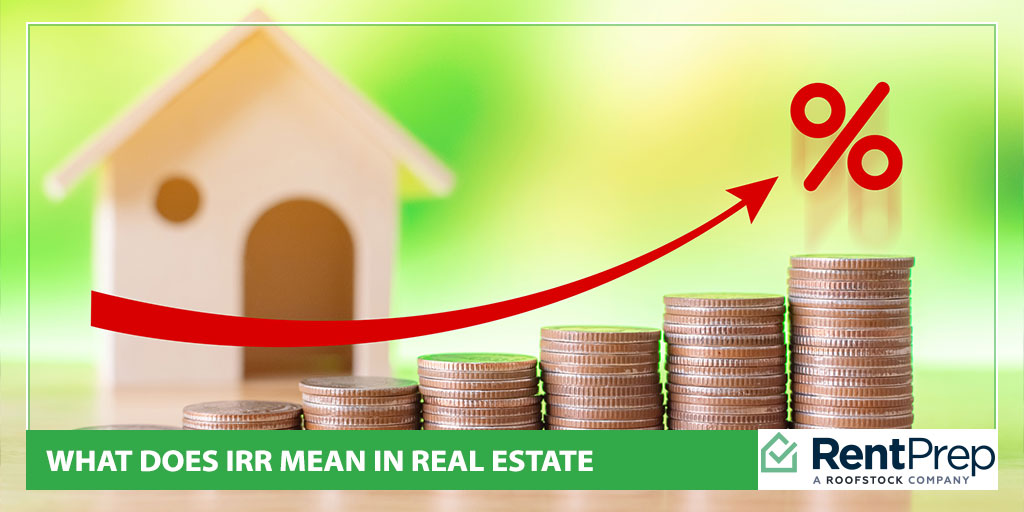
As a landlord involved in rental property investment, you’ve probably heard the term IRR tossed around. IRR, or internal rate of return, is more than just a buzzword, though—it’s a key that unlocks the true potential of your real estate ventures.
Few metrics give as much insight as the IRR. It’s more than just a percentage; it’s a compass that guides you through the vast investment landscape, ensuring you’re always headed toward profitability.
Whether you’re a seasoned investor or just stepping into the real estate arena, understanding IRR can be a game-changer.
In our guide, we’ll explain what IRR means in real estate and show how it’s different from other well-known investment evaluation methods, such as ROI (return on investment) and RRR (required rate of return).
But understanding IRR is just the beginning. We’ll guide you step-by-step on how to calculate it, giving you the tools to forecast the potential profits of your property investments.
Table Of Contents – What Is IRR In Real Estate?
If you’re investing in rental property, IRR calculations can help you determine how much the value of your investment is likely to increase year over year. Find out more about what you need to know in our guide to all things IRR.
- What Is IRR?
- Why Should You Care About IRR?
- How Is IRR Different From ROI And RRR?
- How To Calculate IRR?
- Limitation Of IRR Calculations?
- What Is A Good IRR For Real Estate Investment?
- FAQs About IRR And Property Investment
- Determine Your IRR
What Is IRR?
IRR stands for internal rate of return. It’s not a property-specific calculation but a metric used to analyze any capital investment and evaluate the potential profitability of a project.
It does this by estimating the future value of an investment as if it were valued in today’s dollars.
Why Should You Care About IRR?

As a rental property investor, you can use IRR to help you decide whether a specific rental property will be profitable.
IRR can also help you compare and choose among various property investment opportunities by evaluating them in a comparable way. For example, it offers a simple way of comparing the potential profitability of an apartment block with multiple low rents versus two-family homes with premium rents.
In IRR’s simplest terms, imagine that you’re looking at buying a new rental property. Before you commit to that investment, you want to predict how much the property is likely to earn for the period of time you intend to hold onto it. This is when you will make an IRR calculation.
The calculation considers the initial investment and your expected future cash outflows against the income you expect to receive from the property. It boils down this information to a percentage that represents your annual rate of return if you hold the investment for the anticipated period of time that you specify for the calculation. So IRR basically tells you how much the value of your investment will grow each year.
This number can be compared to the “cost of capital” or the “required rate of return,” which represents the minimum return you need from an investment in order to make it worthwhile. If the IRR is higher than the cost of capital, it’s considered a good investment.
As a rule, the higher the IRR percentage, the better the investment. You can use this to rank and compare multiple investment opportunities.
How Is IRR Different From ROI And RRR?
Based on this description, many people ask how IRR differs from ROI, besides being more difficult to calculate.
First of all, ROI simply calculates the difference between what you spend on an investment and what you gain. It doesn’t account for the devaluation over time; therefore, money earned near the beginning of the investment is more valuable than what you earn near the end.
Since IRR looks at an annual growth rate, which could be called “how much more of an investment you own” rather than an overall profit, it’s easier to use this figure to compare different investment types.
Both of these calculations differ from RRR, or required return on investment, which is basically what you need to earn on an investment property each year to make it worthwhile.
All three are valuable calculations when assessing the viability of a property investment.
How To Calculate IRR?
IRR is a fairly tricky calculation, so it’s used less often than simpler calculations such as ROI. Plenty of online calculators and spreadsheet formulas are available to do the calculations for you; however, your IRR calculation will only be as accurate as the information you provide.
There are a few pieces of information that you’ll need to make your initial calculation. First, you need to identify the time period for which you would like to calculate the value of your investment. Depending on the nature of your investment, this could be days, months, or years, but it’s likely to be years for rental properties.
Next, identify the current value of your property, which is probably the purchase price, and the value that the property is likely to have at the end of your investment period. For example, if you buy a property for $100,000 today, you might estimate that it will be worth $120,000 on the market in 10 years.
You then need to identify your cash flows for each period. The initial cash flow is likely to be negative as this is when you purchase the property and make any major investments in refurbishment and so on.
For your $100,000 property, imagine you make a 20% downpayment of $20,000 plus about $2,000 in fees. You then invest an additional $15,000 to refurbish the property and get it ready to rent. So, your initial investment is $37,000.
You then need to estimate your cash flow for the subsequent periods, which is likely to be positive, as it should be the income you’ll receive from the investment, probably through rents, minus what you spend on the property for things like standard upkeep, finding new tenants, and paying off financing.
But, you need to discount these future values to estimate what the value of the cash flow of future years is worth in today’s dollars.
To better understand, take the following example: $2,000 today earns $2,000 x 10% (so $200) in a year’s time, or $2,200 That $2,200 is a prediction of future value, so $2,200 in the future is worth $2,000 today.
Let’s consider our $100,000 rental property again. Your intention is to hold the property for 10 years before selling. You estimate your cash flow for each year, which will be your income from rent minus your costs for maintaining the property, paying the mortgage, and so on.
Let’s say that you estimate this to be $8,000 a year and provide a present value estimation of 5%. This means that in the first year, your $8,000 cash flow will have an estimated present value of $7,619.05, which is $8,000 / (1 + 0.05)^1.
In the second year, that $8,000 cash flow will be worth $7,275.50 since it’s calculated to the power of 2. By year 10, that $8,000 cash flow is worth $5,884.73 since it is calculated to the power of 10.
You need to apply the same calculation to the future value of your profit in 10 years. So your property worth $120,000 in 10 years is actually worth $72,913.88 in today’s dollars, calculated as $120,000 / (1+0.05)^10.
Calculating your initial expenses and your cash flow for each year, plus the property’s value at the end of the 10-year investment period gives you your net present value, or NVP. You can then use NVP to calculate IRR.
You do this with the following equation and solving NVP for zero. Whatever the percentage is for this is your IRR.
PLEASE ENTER IMAGE FOR FORMULA – NPV=t=0∑n(1+r)tCFt
Of course, you don’t need to do this calculation yourself. Use an online calculator or speak to a financial advisor who can break down the investment in a spreadsheet with appropriate formulae.
What did our example investment yield? The answer is an IRR of 4.26%, which suggests that you are gaining 4.26% on your investment each year.
Limitation Of IRR Calculations

While IRR is a useful tool for assessing investment, it’s important to understand the limitations of IRR as an analytical tool.
IRR only works well for investments that involve an initial outflow followed by a series of inflows. Multiple outflows and inconsistent inflows can make IRR complex and inaccurate. It also doesn’t account for risk or uncertainty in future cash flows but, rather, assumes they are a regular certainty. But this is why IRR works relatively well for rental properties, as, in most cases, the investment does follow a fairly standard pattern.
IRR also doesn’t provide straightforward investment advice, as a reasonable return on investment depends on the individual and also the type of investment.
What Is A Good IRR For Real Estate Investment?
There is no single answer to this question because it depends on so many factors, but it is possible to generalize.
If you’re talking about a rental property that you bought outright without a loan, between 6-10% IRR is considered a pretty good rate for a property that you intend to hold for between five and 10 years.
When you have debt on the property, you should look for a higher IRR of between 7-20% for a five- to 10-year investment period.
You can learn more about IRR and other real estate investing tips in these best real estate books for investors.
FAQs About IRR And Property Investment
Below are answers to some of the most frequently asked questions about IRR and property investment.
What is the IRR rule?
The major rule of IRR is that if IRR is equal to or higher than the required rate of return, an investment is worth considering. But if it is lower than RRR, the investment should be rejected, as you will likely lose money over the course of the investment.
Does IRR indicate risk?
Unfortunately, IRR does not have the capacity to assess risk when calculating the annual return on investment for a property. Nevertheless, a low IRR represents a higher risk as there is a smaller margin, and therefore any problems may see you fail to break even. Higher IRRs mean you have more cushion when things do go wrong.
Determine Your IRR
Smart property investors take the time to assess the rate of return on their investment. IRR is an extremely valuable tool for this kind of assessment. This is because IRR calculates what your investment will be worth over time in today’s dollars, which helps you to better assess the value of the investment you are making today.
IRR also makes comparing investments easier, especially if there are significant differences between them.
IRR is a complex calculation, and while there are many online tools that can help you determine IRR, it can be a good idea to speak to a financial advisor to fully understand the implications of this calculation.
You can learn more on this podcast episode about how to structure rent-to-own investments.

